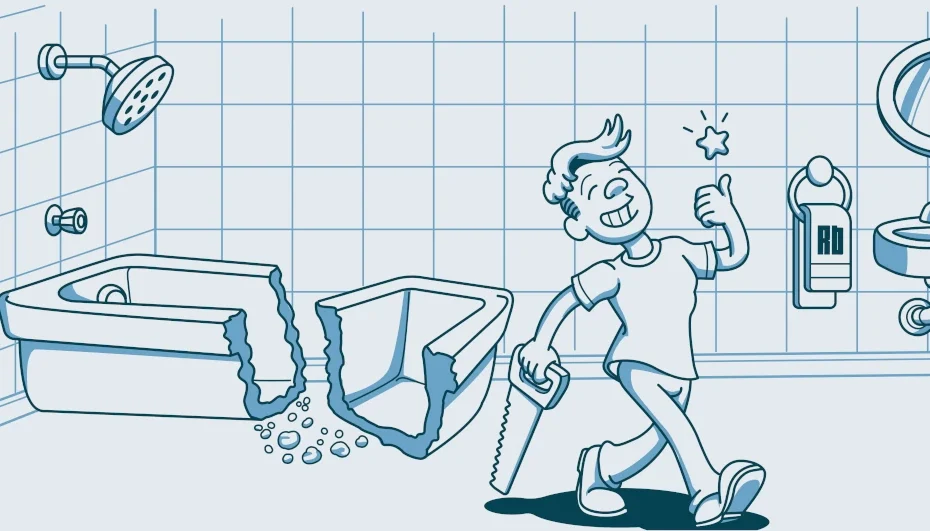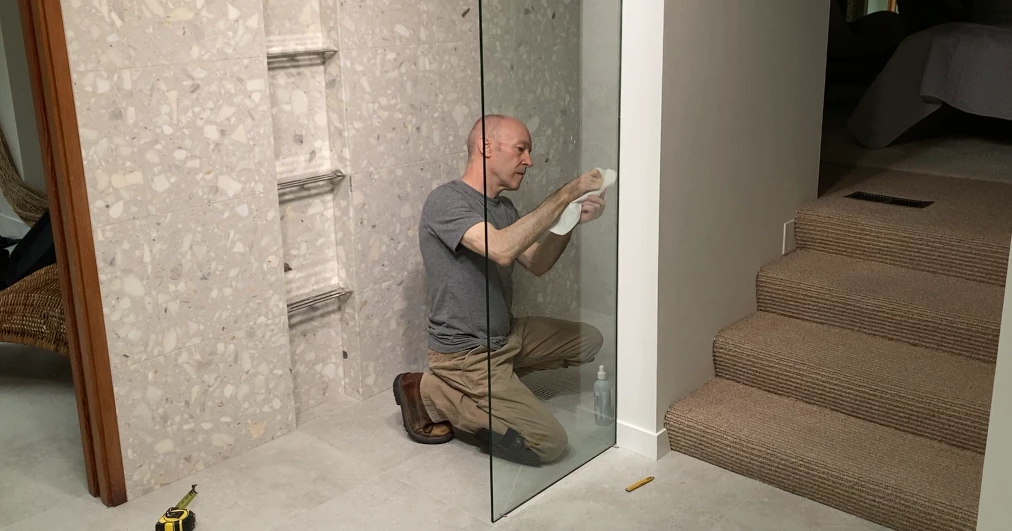Tired of your old 1970’s avocado green bathtub (or equivalent) and considering a bathtub conversion to shower? If so, you’ve come to the right place.
Converting a tub to a shower is not super complicated, but there are good ways and bad ways to approach this type of project. I will show you the best way to convert your tub into the walk in shower of your dreams, while also saving you money, and a lot of headaches along the way.
I’m Steve Gehrmann (Steve’s Bio), a bathroom remodel pro with 20 years of experience, here to provide you with all the details on how to do this yourself, or how to hire a contractor to do it. And I’ll be providing examples and pics from an actual bathtub conversion project I finished recently.
Here’s a comment from one of my satisfied readers,
“Thank you for the great article and for all the additional answers you’ve given”
Scott
Ok, enough about me… Here are the “Before” and the “After” pics of the shower bath conversion project I’ll be guiding you through in this article.


The Basics of a Tub to Shower Remodel
A bathtub conversion to shower involves several basic steps: Removing or demolishing the old tub and tub surround (often the surrounding bathroom floor tile as well), removing and/or re-routing water supply and drain lines, installing a new pan and drain system, installing new wall board, waterproofing everything, then installing your favorite tile or other finished shower wall surface material.
All the above steps are quite involved, so I will spend a fair bit of time on each stage. My goal is to give you the knowledge and confidence to do this project yourself. Or if you’d prefer to hire a contractor, I’ll give you the knowledge and insight to manage your own project like an expert.
Main Reasons: Functionality, Aesthetics, Accessibility
The main reason that most of my clients decided to do a bathroom tub to shower conversion is basically because they never take baths anymore. The second is that their tub is worn out or outdated and their looking for a change. The third reason is that they always wanted a curbless, or walk in shower (WIS).
Bathroom shower conversions are also an opportunity to, not only create a functional space, but also create a space that’s aesthetically pleasing. This is a high priority for most of my clients with budget being the main limiting factor.
There have also been a few projects where the main objective of the bathtub replacement to shower was to improve accessibility. These are all curbless installations of course. This allows someone with mobility issues to move in and out of the WIS without obstructions. These projects also typically involve grab bar installations, hand showers, and benches.
The project I will be detailing in this post is a typical curbless installation, not for mobility’s sake, but for simply for the beauty of it. As such, my client chose not to install any grab bars or bench but did decide on a dramatic floor to ceiling custom storage recess (niche) with stainless steel shelves.
Tub to Shower Conversion Planning
Before embarking on your bathtub into shower conversion, I always recommend that some kind of design/ layout tool be used to plan the new space. Unless you are planning to hire a bathroom designer, this is pretty important in my opinion, and also pretty easy to do.
Just because you’re simply replacing a tub with a shower doesn’t mean that bathroom remodel planning should be ignored. A few of my clients that hired me to do their bathtub conversion to shower project have neglected to consider how this project might influence/ affect the bathroom layout/ design, and they’ve eventually come to regret this approach.
The entire bathroom space has a very different feel once the tub is gone and shower installed in its place, so the space usually benefits greatly from some bathroom design planning. As such, I would highly recommend that you review my Bathroom Remodel Planning post, but I will also summarize some of the important steps below, specifically related to showers.
Tub Remodel to Shower – Design and Layout
Think about the overall style and feel you want to achieve in your new shower.
If you prefer a sleek and modern aesthetic, large-format porcelain or natural stone tiles are great options. For a more traditional look, something like classic white subway tile with contrasting grout is an easy choice. For a budget-friendly option, acrylic shower panels are available in numerous colors and finishes.
I always recommend that my clients look online for bathroom images to find the look they prefer. This is a fool proof method because it gives you the confidence that your bathroom will look great when the projects done, and it really helps your contractor(s) know exactly what kind of look you want, and what kind of materials to prefer.
You should also keep in mind that your new shower doesn’t need to have the same footprint as the old tub. Depending on how big your bathroom is, you could consider a few different pan styles and shapes, from a neo-angle corner shower to a super big luxurious curbless shower with little or no obstructions.
Tile-Ready Pans/ Trays
Ad: The images above and some text links below are Amazon affiliate links. See affiliate disclosure page for details.
There are several prefab tile-ready foam bases in various shapes and sizes to consider, all with different drain orientations to suite your specific bathroom floor drainage location.
When my clients’ budget is a bit too lean for a curbless WIS, but they still want the elegance of tile, I always suggest the less expensive above grade tile-ready pans. This usually means a prefab foam pan/ tray like the Wedi Fundo Primo, or the Schluter Kerdi pan (both pans shown above). These are both tile-ready pans that are installed over the subfloor, with a curb surrounding them.
You should also keep in mind that most tile-ready foam pans/ bases can be modified to match your space (or your drain location). Even if the manufacturer doesn’t offer an extension kit, you can always cut a larger one down to size or extend a smaller one with dry pack mortar so that it conforms perfectly to the shape and size of the location the chose for your new shower.
Finished Pans/ Trays
Ad: The images above and some text links below are Amazon affiliate links. See affiliate disclosure page for details.
There are also plenty of finished shower pans to choose from in materials like acrylic or cast iron, and in different styles, if you don’t like the look and/or expense of a tiled pan (see an example of both types of pans above).
The most common types are the acrylic/ fiberglass pans/ bases. These are the ones you see basically everywhere. They’re also the most economical, often plain white, and have a shiny plastic-like look and feel to them. They are quite durable and can last for many years.
However, the plastics in these pans will break down over time, causing discoloration and cracking, but the deterioration rate varies a lot depending on a few factors. I’ve found that the good pans can still be in great shape after 10+ years of use. You just have to make sure you get a reputable brand because quality varies greatly.
DIY or Hiring a Contractor?
I would recommend that you hire a company that specializes in bathroom demolition to remove your bathtub, demolish the tub surround, and remove all the debris.
However, if you’re set on doing the demo yourself, please refer to my Ultimate demo guide for all the info you’ll need to prepare for and perform the demo safely and efficiently.
As far as hiring a contractor for some or all of your shower build, there are many pros and cons, that I will not go over here. It would be better if you read my bathroom remodel planning post to get the full scoop.
DIY Hints
A great, low skill diy task is installing the back framing for the new valves, hand shower couplings, bars, etc. Plumbers often do a very poor job on this, so this is your chance to get this done right and reduce your plumbing bill at the same time.
Another important but easy DIY task would be flattening the stud plane before you install your new tile backer board. This is a step that few contractors bother with, yet it can make the difference between a smooth and successful tile installation or a tile lippage nightmare. Check my DIY Walk In Shower post for more info on this procedure.
If you’ve got some basic plumbing knowledge, you could also consider running the new water lines yourself, but I would suggest that you hire a licensed plumber to do all the water connections and all the drainage work. This reduces the risk of things going sideways in your bathtub conversion to shower project, and ensures that you comply with local building codes.
It would also be a good idea to discuss your diy plumbing plans with your chosen plumbing contractor so that he/she knows and approves of them. I think you’ll find that most plumbers are pretty good about this, as long as you don’t do any of the final connections. As licensed contractors, they are legally responsibility for all the plumbing work, so you need to be sensitive about this.
If you have the skills and feel confident, you can of course do almost all the rest of the work on your bathtub conversion to shower project (aside from the plumbing work mentioned above). If this is indeed your plan, I would suggest that you read my DIY Walk In Shower post. This article will give all the info you need to build a beautiful walk-in shower diy style.
Budgeting
While a bathtub conversion to shower can be a slightly more cost-effective remodel compared to a full bathroom remodel, it is definitely not considered a budget remodel.
The shower is often the most expensive part of a bathroom remodel project. As such, it’s essential to establish a clear budget before starting your project, and to determine whether you’ll be doing it yourself (diy) or hiring a contractor. This difference will be the biggest budget influencing factor.
If you’d like some more detailed info on this topic, please check out my Bathroom Remodel Budgeting post, but I will include a few budgeting tips, related specifically to a bathtub conversion to shower.
Quick Budget Tips
The first thing I should mention is that a walk-in shower, like the one I am referencing in this post, is a fair bit more expensive (in terms of labor changes) compared to a regular above grade acrylic shower base install. So, if you’re planning to hire a contractor to do most of this work on your bathtub conversion to shower project, and if your remodel budget is a primary concern, you may have to give up on the idea.
Tip 1:
But if you’re planning a diy project, my advice is that you shouldn’t shy away from a Walk In Shower. It will take a fair bit more of your time then a regular above grade acrylic base install, but the additional material costs basically amounts to only the shower floor tile expense. This makes it not significantly more expensive than a regular above grade acrylic shower base installation.
Tip 2:
In my experience, when I’m building a shower for a client, the labor costs and material costs are often very similar when these clients prefer a slightly above average “grade” of remodel.
You can check out my Bathroom Remodel budgeting post to see exactly what I mean, but this usually represents slightly fancier than average materials. Materials that are not considered “budget” items, but rather one or two grades more expensive than this.
Just keep in mind that this may not represent your costs at all if you’re hiring a “premium” contractor, OR if you decide on a few fixture items that are very high-end.
Tip 3:
If you’re going to hire a contractor for most of the work, you should always get a few quotes from some well rated contractors in your area and try to get them to provide as much detail as possible. A very common strategy used by many contractors is to produce a lower priced quote that’s short on details.
The idea is to secure the client, then figure out ways to make more money during the project. This is a very difficult tactic to spot because unforeseen extra jobs and material expenses always come up in every project, but it’s a very real strategy, nonetheless.
The best way to avoid this problem is to make sure you hire the most reputable contractors in the area. It’s actually best if you get a recommendation from a trusted friend than to rely on online reviews, but these are important as well.
Tip 4:
When searching for materials for your bathtub conversion to shower project, you can save a lot of money if you’re willing to put some time and effort into it. For example, tile patterns are retired routinely and replaced with the hip new styles. So, ask around at your local home improvement store, and you might find some amazing deals on discontinued tiles.
Bathtub Conversion to Shower – Demo Phase
Once you’ve chosen your desired shower design, it’s time to dive into the step-by-step bathtub conversion to shower process.
A promised, I’ll be going over the important steps involved in a bathroom tub to shower remodel project that I recently completed – the walk in shower I mentioned above, with a custom vertical, floor to ceiling wall niche.
This does not mean that you need to build this particular shower, but since the planning and preparations are similar with any bathtub replacement with shower, I thought it would be helpful to use a real project to help you understand each step more clearly whether you’re DIYing or hiring a contractor for most of the work.
Preparing Your Space and Gathering Tools
Before beginning your bathtub conversion to shower, you need to protect your bathroom floor if you’re not planning to reinstall new floor tiles during your remodel. Existing floor tiles will be very vulnerable to chipping and impact damage if you are planning to keep them, so they definitely need protection.
If you’re considering keeping your existing bathroom floor tiles, I would strongly suggest that you reconsider. This is your chance to replace these tiles, and you probably won’t get another. FYI, almost all of my clients that decided to keep their existing floor tiles ended up regretting it later.
At this point, you also need to do all the demo prep that’s involved in any remodel, including getting all your demo tools together, and the right safety equipment (if you’re DIYing it), as well as coming up an effective dust management plan. Check out my ultimate demo post for all the info you’ll need for this important first step.
Removing the Bathtub and Plumbing
The next stage of your bathtub conversion to shower project is removing the old bathtub, old valves, trims, old drainage lines, and old water supply piping. The first step of this process is to shut off the water to the bathroom, then remove the faucet, valves and drain assembly.
As you can see in the image, I usually remove these old tub drains by jamming my handy lineman’s pliers into the drain opening and using channel lock pliers to unscrew the drain body. These drains rarely come off easily, and they’re often rusted in place, so you’ll need this extra leverage to loosen it.
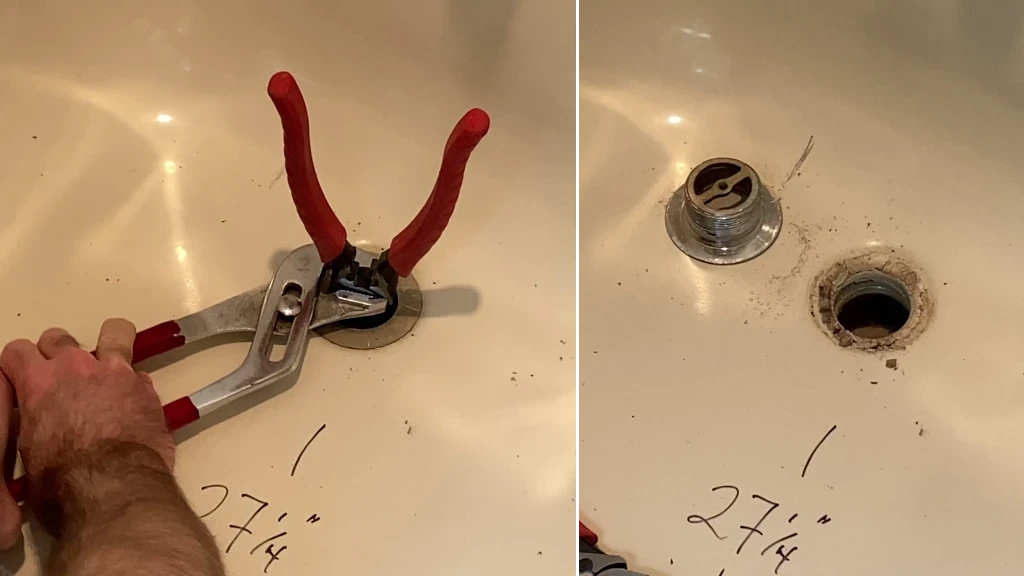
To remove the bathtub, you’ll also need to disconnect and remove the tub overflow assembly. Keep in mind that there is a piece behind the trim that will be stuck to the back of the tub, so make sure you just give it a whack with your hammer to release it before tub removal.
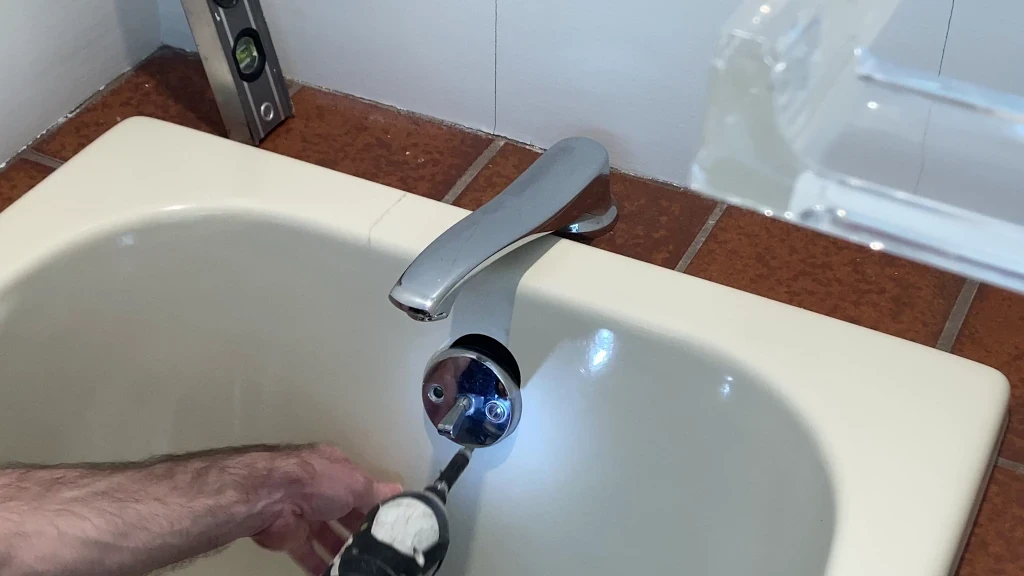
I would suggest that you also remove the valves and tub faucet before attempting to remove the tub, whether they are connected to the tub or not. They always get in your way if you leave them in place.
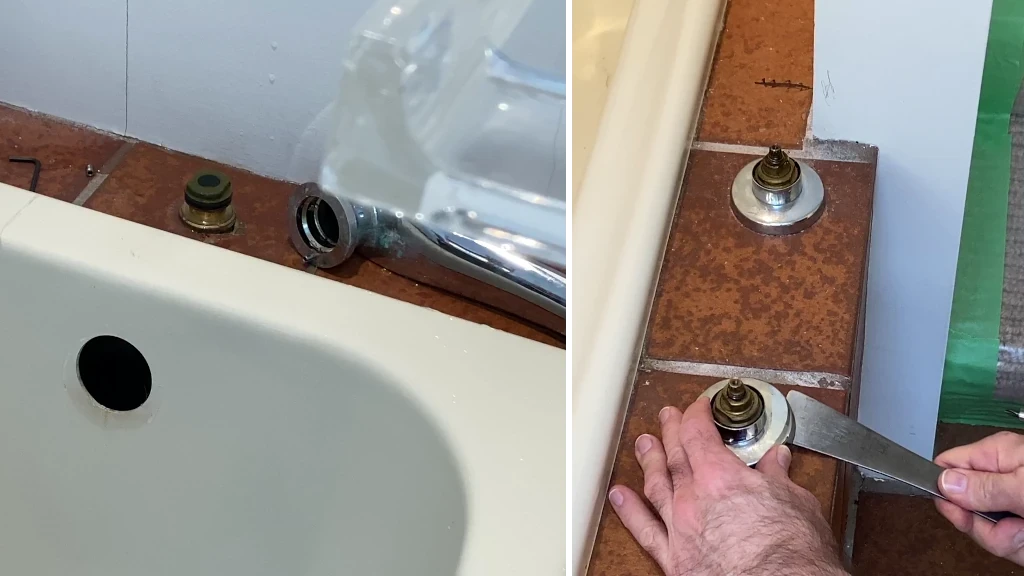
Since the old bathtub in this project was installed into a tub deck, it was actually a bit easier to get out than the average tub installed in a wall alcove. As such, I thought I would give you a few hints about how to detach and remove an alcove tub first, since I’ve done this dozens of times.
First you need to remove the wall surface surrounding the tub. I would strongly recommend that you remove the entire wall surface first, right down to the studs. The tub installation flange is always attached to the studs, under the wall tile, so it’ll make your tub removal easier, and you eventually need to remove the wall surface regardless.
Then simply pull the nails or unscrew the screws attaching the tub to the wall studs. The next step is the fun part, removing the old tub. Whether you’re removing an alcove tub or a tub installed in a deck the strategy below works well for both.
I always cut the old tub into manageable sections with my reciprocating saw to make it easier to handle and easier to dispose of. Whether it’s a steel tub or acrylic/ fiberglass, it’s the best strategy in my opinion.
To cut effectively, you need some new saw blades because the tub will tend to vibrate a lot if the blade’s not sharp. If you need to start with a long blade as I did (see image), try to switch to a shorter blade as soon as possible to avoid cutting anything behind the tub. For this same reason, try to cut as shallow as you can throughout the cut (see image).
If the tub vibrates too much during cutting, switch to a short blade and try planting the heel of the saw against the tub. This usually helps reduce vibration and facilitate cutting.
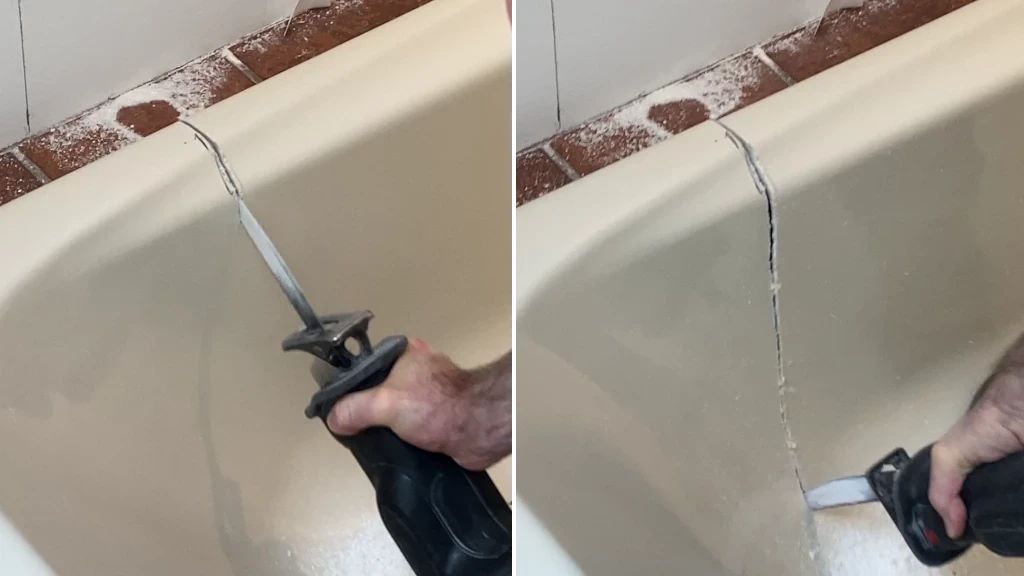
Be cautious when doing these cuts. In other words, make sure the blade is totally clear and your not cutting near any electrical wires, water lines, and drainage lines. Once the tub is cut into a few sections, it’s much easier to dispose of.
Once the tub is out, it’s a good time check the surrounding area to make sure you didn’t cut anything you weren’t supposed to.
Many older bathtubs have a layer of mortar beneath that you’ll have to remove. Just go nuts on it with a good pry bar and sledgehammer and dispose of the chunks.

After I removed the tub deck framing and cleaned up all the debris, you can see below that I needed to get my electrician to re-wire that Romex wire back into the stud wall framing. The original electrician was being lazy and ran it through the tub deck instead of the wall.
There are always at least a few surprises like this that come up during every demo. This small task added another $300 to the homeowner’s budget. A good example of why a little extra money in the budget is important for contingencies.

I also needed to remove the copper water supply piping above and below the subfloor. I addressed this during the next step in the project; the Shower Build Phase.
You should also take this opportunity to inspect the exposed wall studs and subfloor for any signs of water damage or rot. If there are any problems like this, they can be addressed in the shower build phase.
Shower Build Phase
With the old tub gone and the space prepped, your bathtub conversion to shower project has now reached the shower build phase!
As I mentioned above, the shower build is covered in great detail in my DIY Walk In Shower post. This will allow you to build the super cool curbless shower with the floor to ceiling shower niche, that I’ve been referencing in this post.
But even if you’re budget doesn’t allow for a Curbless Shower Build, my DIY Walk-in Shower post can help you with all the fundamentals.
An acrylic shower pan install may not require as much subfloor reconstruction work as a walk-in shower, but pretty much every shower install requires some perimeter wall reinforcement, and benefits greatly from some subfloor reinforcement.
Good luck with your project!
FAQ
What is the average cost of converting a bathtub into a shower?
The average shower conversion cost ranges from $2,500 to $6,000, depending on the size, materials chosen, and if you’re paying “premium” labor costs. Budgeting for materials, labor, and a contingency fund for unexpected expenses is crucial.
How long does a typical bathtub to shower conversion take?
A shower conversion can take anywhere from a couple of weeks to a couple of months, depending on the project scope and whether you’re doing it yourself or hiring professionals. DIY projects typically take longer than those handled by experienced contractors.
Can I convert my bathtub into a walk-in shower by myself?
While converting a bathtub to a walk-in shower is achievable as a DIY project, it requires some renovation skills. You’ll also need the right tools, a solid understanding of the process, and a significant time commitment.
Can I avoid using grout when converting my bathtub to a shower?
The simple answer is no, but there’s no reason to avoid grout in your bathtub conversion to shower project or any tile installation. Water resistant grouts like Mapei Flexcolor CQ or epoxy grouts solve the problems of grout staining and cleaning, so there’s no reason to avoid grout lines.
